|
Protected Area
|
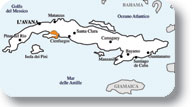 |
- Park Authority: Ministerio de Ciencia Tecnología y Medio Ambiente
- Headquarters: Calle 20 No. 4110 esq. 18-A, Playa - Ciudad de La Habana (Cuba)
- E-mail: ama@unepnet.inf.cu
- Area: 6,000 km2
|
|
Nature
|
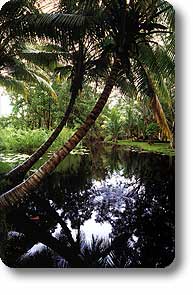

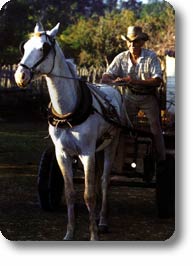

|
Ciénaga de Zapata covers the southernmost part of the province of Matanzas, for a total of 6,000 km2; it includes the Municipalities of Unión de Reyes, Jaguey Grande, Caliente and the area of the insular platform. It stretches for 175 km from east to west, between Punta Gorda and Jagua, with a maximum width of 58 Km from north to south, from Sur de Torrente to Cayo Miguel, and an average width of 16 km.
The 75% of the territory is covered with marshes and brackish lagoons, forming the main wetland of Cuba and the largest and best preserved wetland of the Caribbean islands.
The section which has entirely emerged consists of strata of marine origin where highly water-soluble carbonate rocks dominate. Ciénaga is a wide plain whose altitude goes not beyond the 6 meters above sea level. This huge plain is divided into two well-defined areas, situated at both edges of Bahía de Cochinos: Western Ciénaga, a lower area bordering with the province of Havana, presenting a low coast, and Eastern Ciénaga, bordering with the province of Cienfuegos, higher than the other one and characterized by a relatively higher and rocky coast. Crossing the Peninsula from east to west, you will find in the central area a higher calcareous rock penetrating the western region (low and flooded) and giving origin to what is usually called the "upper section of Ciénaga" or non-flooded area.
Like the rest of the Cuban platform, the seabed consists of a system of marine plains and terraces originated from slight lowerings of the surface and changes of sea level. Today. these terraces are covered with corals, sponges, and other living organisms giving the area a unique aspect.
The Soil
The continuous deposit of organic substance on the calcareous rock and the intense decomposition progress involving it, favored by the particular water regime of the area, lead to the formation of the peat, a kind of soil dominating in the region. The western area is characterized by a greater concentration of peat, with soils formed by a greater quantity of muddy and sandy material; the eastern area consists of bare karstic rock, on which vegetation grows. In the easternmost area there are sandy dunes of more than 2 meters of height.
The karstic rock of the periodically flooded areas and marshes is covered with clayey mud deposits, friable soils and peat, whose thickness goes from 2 to 10 meters. The karstic processes appear in the underlying calcareous rock as dolines deriving from dissolution or collapse processes and as karstic lakes. In the peat stratum, processes leading to the formation of small dolines often take place.
The Ecosystems
The great variability of the region, deriving mainly from the water regime and the structure of the soil, transforms Zapata in a mosaic of vegetation and landscapes: as a matter of fact, vegetal formations which have been entirely or only partly flooded, woods developing in non-flooded areas, and xerophytic vegetation alternate. The ecosystems characterizing Ciénaga are the following ones: |
|
|
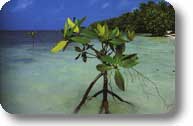



|
Mangrove Swamps
In the island of Cuba, the mangrove swamps cover an area of 5,321 km2 (4,8% of the island surface and 26% of the total forest surface) along a coastal perimeter of 5,476 km. These important formations are present in almost the 70% of the coasts and are considered as the main natural forest formation of Cuba and the largest and best preserved of the whole Caribbean area. It is a vegetal formation characterized by only one arboreal stratum where the four Cuban mangrove species grow: the Red Mangrove (Rhizophora mangle), the Black Mangrove (Avicennia germanis), the White Mangrove (Laguncularia racemosa), and the Button Mangrove (Conocarpus erectus). The most common animals living in the mangrove swamps are the Cuban Hutia (Capromys pilorides) and the Dwarf Hutia (Capromis prehensilis); among birds, the Common Black-hawk (Buteogallus anthracinus), the Yellow Headed Warbler (Teretistris fernandinae), the "canario de manglar" (Dendroida petecchia), and among the reptiles the Cuban Crocodile (Crocodylus rhombifer); moreover, there are also several species of aquatic birds using the mangrove swamp as shelter.
Brackish Lagoons
It is a coastal lagoon system with an average depth of 50 cm, which is not considered as belonging to the sea, since it is delimited by archipelagos formed by small but several islands. They receive important supplies of subterranean and superficial freshwater, often rich in organic substance which is decomposing. Some stretches are characterized by a high saltiness, although varying according to the different supply of subterranean freshwater. Aquatic vegetal species are represented by algae of the genera Caulerpa, Halimeda and Pennicillus and by Thalassia testudinum; animal species by fish like the "macabì" (Alvula vulpes) and Barracuda (Sphyraena barracuda), by Crustaceans (Callinectes sapidus) and by some mollusks. Mangroves grow at the edges of the lagoons, above all Red Mangrove (Rizophora mangle) and Black Mangrove (Avicennia germinans). The presence of the avifauna is linked to the seasons; in the dry season (from the end of November to March) the Salt Pan is populated by over 65 species of migratory birds flying away from the cold of the north (United States and Canada).
Intermittent Lagoons
It is a peculiar formation developing in open areas and dominated by herbaceous vegetation, even if it is possible to find isolated trees and palms, typical of the forest of Ciénaga.
In the wet season, this area is flooded and aquatic plants like the Yellow Pond Lily (Nuphar luteum) and the Dotleaf Waterlily (Nimphea ampla) grow; moreover, it is frequent to see local population while fishing the "biajacas" (Ciclostoma tetracanta).
|
|
The Sea and the Coast
The coast of the western area is muddy and the border between land and sea is well defined by the presence of the mangroves, whose roots and saltiness tolerance enable them to occupy this position. Along the eastern coast, the border between land and see is marked by the calcareous rock called "dog's tooth", controlling the wave motion. In some not very large areas, the rocky barrier interrupts itself and the sand forms small and wonderful inlets called "caletas". The most spectacular one is Caleta Buena, where the homonymous tourist center lies.
Along the tide line, the altitude of the coast goes from 0 to 4 meters. As we move towards the eastern area, the altitude increases and the coast becomes steeper. The rise of the bay is very near the coast and the wall descends with small steps covered with recent elements which are characteristic of the coral bed. Here sponges, petrified corals, very colored fish and mollusks with various shapes are abundant. Along the tide line, there is a great number of sea urchins of various size and small mollusks living clung to the rocks. |
|
Flora
|
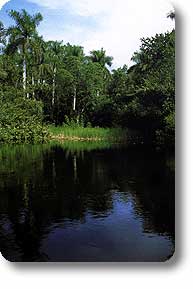

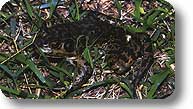

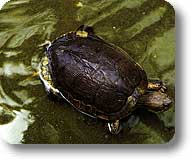

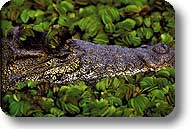

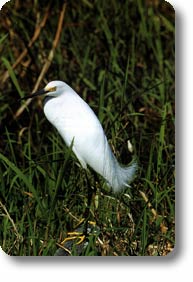

|
According to the data of scientific literature, in Ciénaga de Zapata there are about 1,000 plant species, out of which 130 are endemic species of Cuba and 5 are local endemic species; 17 are endangered and 192 have a real economic, scientific, medical, and culture value. Some of these plants are interesting for their structure and capacity of adaptation.
Aquatic Plants
The aquatic vegetation is well developed in the lagoons, channels, and rivers; there are species floating on the surface of water, like the "helecho", abundant in the waters of the crocodile raising center of Laguna del Tesoro; others live completely submerged by water, like Salvinia auriculata, called "lechuguilla de agua".
Mangroves
Mangroves represent a vegetal curiosity. The long roots of the Red Mangrove are the greatest expression of the capacity of these plants to adapt and live in the first tide line, without running the risk of being carried away by the current or of being destroyed by the waves.
Epiphytic Plants
The term "epiphytic" refers to plants living on other plants without any kind of parasitism or symbiosis.
Epiphytic plants are abundant in Ciénaga: they develop in ecosystems where the relative humidity is high and absorb water from the atmosphere through specialized structures present in their roots.
Carnivorous Plants
In order to live, some plants need to absorb nitrogenous compounds obtained from outer sources, since they cannot acquire them from the substratum they live on. These are carnivorous plants characterized by structures able to secrete substances catching insects which get trapped.
|
Fauna
|
| In the region of Zapata, water is the main responsible of the distribution of fauna. Flooded lands are impenetrable for some animals, but guarantee the success of the adaptation process to others that can fly (insects and birds) and live in the air. The great variety of ecosystems and the differences existing among them favor the presence of a different and heterogeneous fauna.
Insects
Although they represent the largest zoological group of the area, insects have not been studied yet. Wasps and other Hymenoptera carry out a natural biological control, since they are parasites of other invertebrates or eat their larvae. Bees are useful for the forest because of impollination and for man because of honey production. The most studied insects are butterflies.
Marine Fauna
Among the marine species that can move along the coasts of the region, there are: the Caribbean Spiny Lobster (Panulirus argus), the White Shrimp (Penaeus schmitti), the Pink Shrimp (Penaeus notialis) and some bonefish: the Mutton Snapper (Lutjanus analis), the Yellowtail Snapper (Ocyurus chysurus), the so-called "roncos" (Haemulon sps.) and others. These are the species of greatest commercial value.
Mollusks are also important, especially the Caribbean Queen Conch (Strombus gigas), with the biggest shell in the island and seriously endangered.
Freshwater Fish
Among the fish populating the area, we should mention first of all the manatee (Lepisosteus tristoechus), which is an endemic species characterized by a limited distribution and considered a living fossil for the primitiveness of its body structure. It belongs to the group of pulmonate fish and has a capacity of adaptation justifying its survival in Ciénaga until present times.
Another common species of the stretches of water is the Red Parrot Fish (Cichlasoma sp). Also the group of Cyprinoidea is well represented: because of their small size, they are called "guajacones".
|
|
|
Amphibians
Toads are the biggest amphibians living in the area. They look like frogs, but they are characterized by a bigger size. They have a dry and warty skin and, unlike frogs, they do not stay in water, but they can be found under the stones, in the forest and under the foliage. Frogs are more common and linked to the aquatic environment. The Bullfrog (Rana catesbeiana) is the biggest frog in Cuba; it has been introduced in the Country for economic purposes and has colonized all the stretches of water. Its name derives from the low sound it lets out, similar to that of a bull; it is hunted by the local population for its delicious meat.
Reptiles
The reptiles living on the island are probably 121, but no more than 50 of them live in the area of Zapata; therefore, probably it is not the reptiles' favorite area of Cuba (another possibility is that the group has not been thoroughly studied in the area). Despite this, thanks to the variety of habitats characterizing Ciénaga, all the individuals belonging to this class have here some specimen representing them and it is curious to notice how all the habitats are characterized by one species each.
Mammals
In Zapata, as in the rest of the island, mammals are not the dominating zoological group. Among the mammals living in the forest, the most important one are the Cuban Hutia (Capromys pilorides) and the White-tailed deer (Odocoileus virginianus), a deer introduced from North America, while in freshwaters, although rare, there is the manatee (Trichechus manatus), an endemic mammal of the Caribbean area, reintroduced in Laguna del Tesoro and Rio Hatiguanico.
Birds
The great diversity of ecosystems in Zapata particularly favors this group, which is the most represented one in the area and the most thoroughly studied. Out of the 354 bird species recorded in Cuba, 230 live in this region, that is the 65% of the Cuban avifauna. Ciénaga protected areas system offers shelter to the 68% of the endangered species in Cuba, that is 13 out of the 19 present in the Country.
Moreover, Ciénaga is the area in Cuba with the highest number of endemic species. Here the 6 genera and 18 out of the 21 endemic species of the Country live. The concentration of local endemic species in Zapata is for scientists the most surprising aspect.
|










